ECS LIVA Z Fanless Dual-LAN Apollo Lake UCFF PC Review
by Ganesh T S on March 30, 2017 8:00 AM ESTPerformance Metrics - II
In this section, we mainly look at benchmark modes in programs used on a day-to-day basis, i.e, application performance and not synthetic workloads.
x264 Benchmark
First off, we have some video encoding benchmarks courtesy of x264 HD Benchmark v5.0. This is simply a test of CPU performance. As expected, the Intel Celeron N3050 turns out to be one of the leaders, with the second pass result going in favor of the AMD A10 Micro-6700T with a much higher TDP.
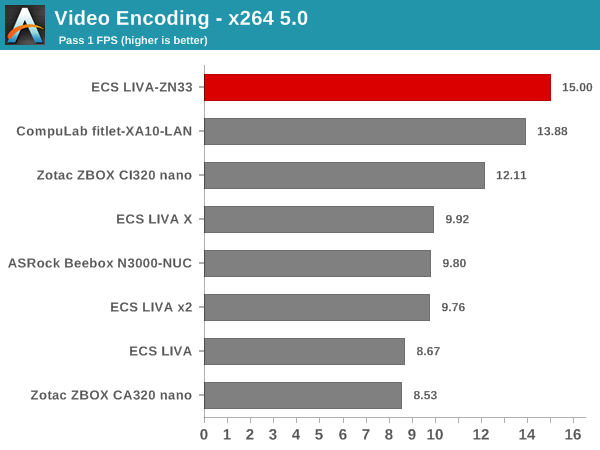
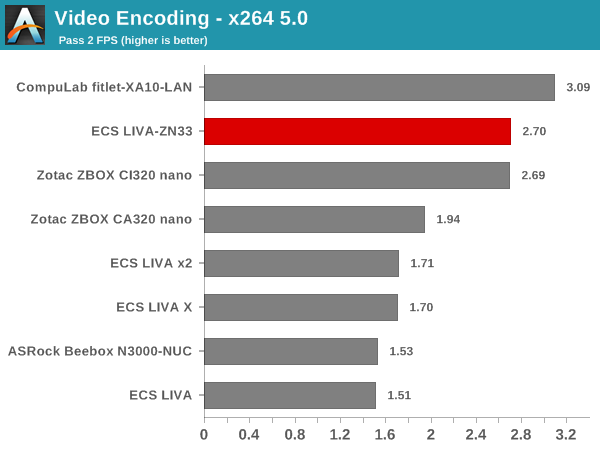
7-Zip
7-Zip is a very effective and efficient compression program, often beating out OpenCL accelerated commercial programs in benchmarks even while using just the CPU power. 7-Zip has a benchmarking program that provides tons of details regarding the underlying CPU's efficiency. In this subsection, we are interested in the compression and decompression MIPS ratings when utilizing all the available threads. The quad-core CPU-based CompuLab fitlet-XA10-LAN and the Zotac ZBOX CI320 nano score much better than the ECS LIVA Z. The decompression numbers for the dual-core CPU-based systems are all around the same ballpark.
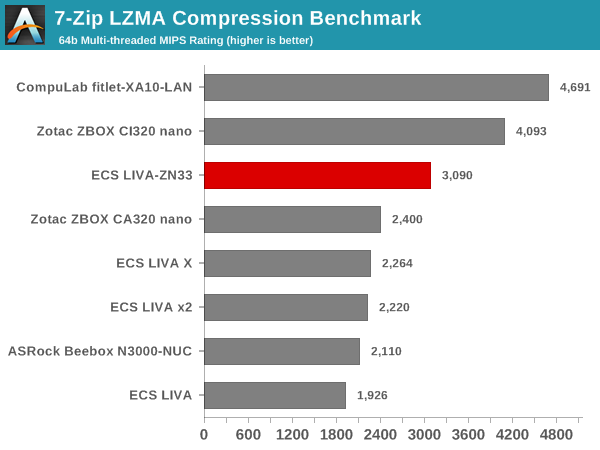
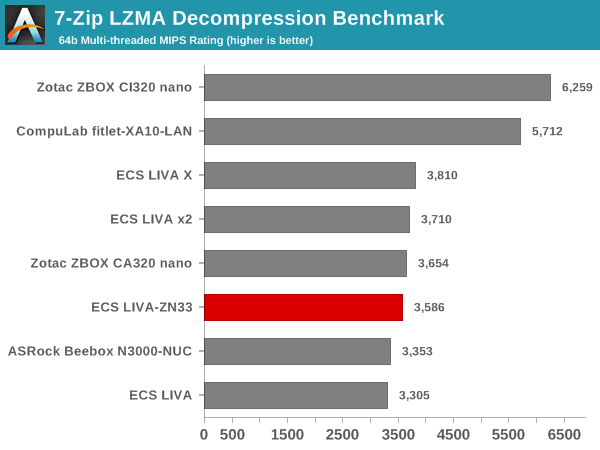
TrueCrypt
As businesses (and even home consumers) become more security conscious, the importance of encryption can't be overstated. CPUs supporting the AES-NI instruction can accelerate the encryption and decryption processes. The Apollo Lake Intel Celeron N3350 does support AES-NI. TrueCrypt, a popular open-source disk encryption program can take advantage of the AES-NI capabilities. The TrueCrypt internal benchmark provides some interesting cryptography-related numbers to ponder. In the graph below, we can get an idea of how fast a TrueCrypt volume would behave in the ECS LIVA-ZN33 and how it would compare with other select PCs. This is a purely CPU feature / clock speed based test.
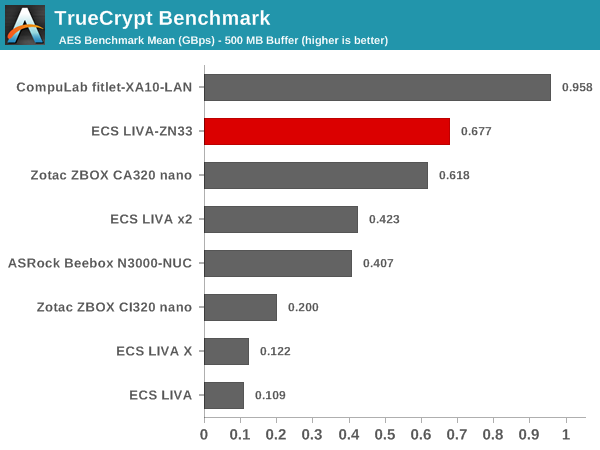
Agisoft Photoscan
Agisoft PhotoScan is a commercial program that converts 2D images into 3D point maps, meshes and textures. The program designers sent us a command line version in order to evaluate the efficiency of various systems that go under our review scanner. The command line version has two benchmark modes, one using the CPU and the other using both the CPU and GPU (via OpenCL). The benchmark takes around 50 photographs and does four stages of computation:
- Stage 1: Align Photographs
- Stage 2: Build Point Cloud (capable of OpenCL acceleration)
- Stage 3: Build Mesh
- Stage 4: Build Textures
We record the time taken for each stage. Since various elements of the software are single threaded, others multithreaded, and some use GPUs, it is interesting to record the effects of CPU generations, speeds, number of cores, DRAM parameters and the GPU using this software.
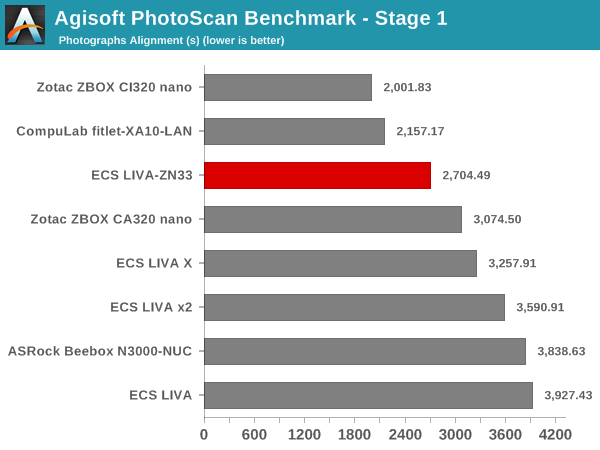
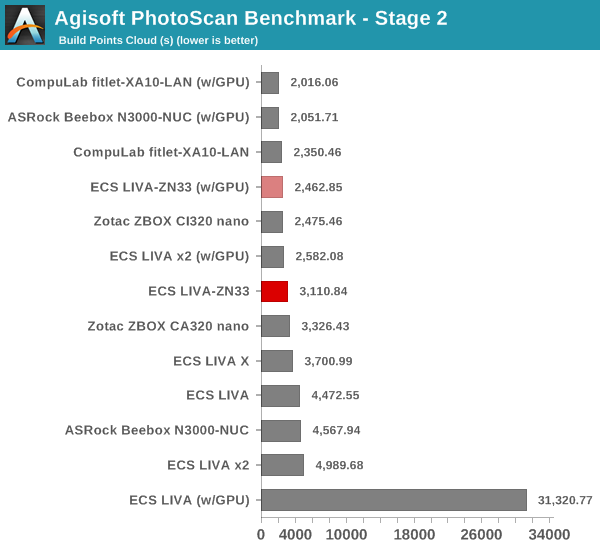
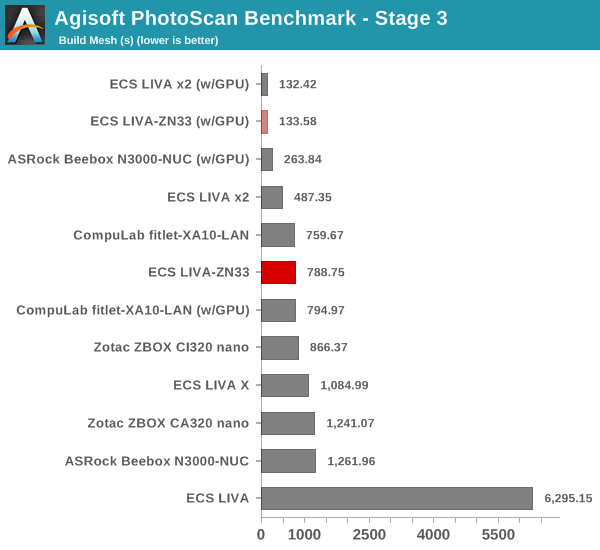
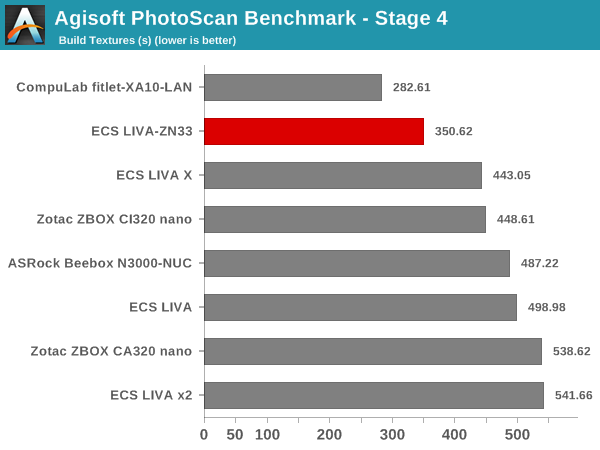
Dolphin Emulator
Wrapping up our application benchmark numbers is the Dolphin Emulator benchmark mode results. This is again a test of the CPU capabilities - in particular, the single-threaded performance plays a major role, and we see the ECS LIVA Z come out on top.











30 Comments
View All Comments
Systab - Thursday, March 30, 2017 - link
Win10 only support is worrisome but expected.The obvious question is how well would it run some sort of Linux server version and what driver problems one would encounter with Win7?
mjeffer - Thursday, March 30, 2017 - link
I'm guessing there are probably Linux drivers for all the components in this machine and would be 100% fine with Linux. Just don't expect ECS to provide any help with it.StevoLincolnite - Thursday, March 30, 2017 - link
Would have been great to see some gaming benchmarks. Especially eSports titles like Overwatch, StarCraft, Counterstrike etc'.nathanddrews - Thursday, March 30, 2017 - link
Not worth it:https://youtu.be/fN8paf1RtHY
Even if it had Iris Pro graphics, the anemic dual-core can't deliver a playable experience. As a Kodi/Retroarch box, it's probably perfect. If you can get Linux running on it, it would also make an excellent pfSense box - but the lack of a quad-core means foregoing some more advanced plugins.
extide - Tuesday, April 11, 2017 - link
pfSense runs on FreeBSD. not Linux, which makes driver support a BIT trickier -- but I bet you could still get it all up and running.BrokenCrayons - Thursday, March 30, 2017 - link
OMG it's adorable cute and for $220, the price isn't bad at all. It badly needs the M.2 SSD to make it usable since ECS skimped on the eMMC drive, but it looks like a really nice little system you could mount on the back of a monitor to keep clutter down. The fact that it's fanless AND has good thermal performance are huge selling points for me.JoeyJoJo123 - Thursday, March 30, 2017 - link
Perfect box for pfSense.[X] Dual Lan
[X] Built in WiFi (not necessary, but nice bonus)
[X] Small
[X] Cost Effective
[X] Built in flash memory (32GB is enough for pfSense and minimal logging)
[X] Support for m.2 SSDs.
[X] Passive heat dissipation design
Realtek LAN controllers are a bummer, but it's OK given that throughput/availability issues shouldn't be strained as most internet connections in the US are measured in tens of megabits, rather than saturating the full gigabit connection anyways.
Also wished it was a bit better than a mobile Celeron, but that is plenty for most internet connections and without too many pfSense add-ons. At the end of the day it is 4core/4threads and can burst up to 2.2Ghz on some single-threaded loads, any more and it might not have been able to be passive at this small form factor.
Really like this, and I'll keep my eye on it.
takeshi7 - Thursday, March 30, 2017 - link
This would be a great homebrew router/NAS combo. I would still get a separate WiFi AP though. That 1x1 configuration on the built in WiFi wouldn't cut the mustard.nathanddrews - Thursday, March 30, 2017 - link
This is the 2C/2T model.JoeyJoJo123 - Thursday, March 30, 2017 - link
Yes, Einstein. I'm not talking about the dual core reviewed here, I was talking about the N3450 model which is also available.https://ark.intel.com/products/95596/Intel-Celeron...
4 cores / 4 threads.